#Árpád Dynasty
Explore tagged Tumblr posts
Text

Constance of Hungary (?-1302), was a Queen consort of Galicia and a Grand Princess of Kiev by marriage to Leo I of Galicia, Grand Prince of Kiev (r. 1271–1301).
She was the daughter of Béla IV of Hungary and Maria Laskarina.
18 notes
·
View notes
Text

King Saint Stephen in the Battle with the Turks. Unknown artist.
#magyar királyság#königreich ungarn#Regnum Hungariae#kingdom of hungary#saints#catholicism#Árpád ház#Árpád-ház#I. István#Stephen I of Hungary#magyar király#Sanctus Stephanus#Szent István király#arpad dynasty#árpád dynasty#Štefan Veľký
3 notes
·
View notes
Text

The Árpád dynasty consisted of the members of the royal House of Árpád (Hungarian: Árpád-ház), also known as Árpáds (Hungarian: Árpádok, Croatian: Arpadovići). They were the ruling dynasty of the Principality of Hungary in the 9th and 10th centuries and of the Kingdom of Hungary from 1000 to 1301. The dynasty was named after the Hungarian Grand Prince Árpád who was the head of the Hungarian tribal federation during the conquest of the Carpathian Basin, c. 895. Previously, it was referred to as the Turul dynasty or kindred.
Based on the data of the distribution, appearance and coalescence estimation of R-Y2633 the dynasty traces ancient origin near Northern Afghanistan about 4500 years ago, with a separation date of R-ARP from the closest kin Bashkirs from the Volga-Ural region to 2000 years ago, while the individual from Serbia (R-UVD) derives from the Árpáds about 900 years ago. As also the separation of haplogroup N-B539 between the Hungarians and Bashkirs is estimated to have occurred 2000 years ago, it implies that the ancestors of Hungarians left the Volga Ural region about 2000 years ago and started a migration that eventually culminated in settlement in the Carpathian Basin.
15 notes
·
View notes
Text

Facial reconstruction of a man, from the Árpád dynasty in Hungary. 9th century CE.
7 notes
·
View notes
Text

What do Otto von Habsburg, Richard Nixon, Yehudi Menuhin, Andrew Lloyd Webber, Vilmos Zsigmond and Maximillian Shell have in common? They all have a suite named after them in the Danubius Hotel Gellért, and stayed there many times. Very little is known about the bathing culture of the Magyars who settled here after their long migration. According to some chronicles, the hot springs of Buda were already known about in the age of the Árpád Dynasty. According to data from 1178, the Johannite religious order founded a hospital at the foot of Gellért Hill. The second golden age of Buda’s spa culture was during an otherwise dark time in the country’s history, the 150-year period of Turkish occupation. At that time, the Gellért Spa was known as “Acsik ilidzsa”, an open-air hot spring bath. According to other traditions, the Turks referred to this place as Aga’s bathing place, or the baths of virgins. After the period of Turkish rule, the spa changed ownership many times. A German travel guide published in 1827 mentions accommodation facilities at the spa, and in 1832 the construction of the first genuinely large-scale hotel and bathing complex got under way. In the 19th century it was referred to as “Sárosfűrdő” (Muddy Baths), and reportedly was a pleasant spa and hotel building, in good condition. It got its name from the healing mud found here, which surpassed that of all the other baths in Buda both in quantity and purity, but has unfortunately run out since then.
5 notes
·
View notes
Text
On the 30th of May is the Feast Day of the Transfer of the Relics of King Saint Stephen of Hungary
The Holy Right Hand is a Hungarian national and catholic relic, said to be the naturally mummified right hand of Stephen I, first king of Hungary, also called Saint Stephen.
Saint Stephen (in Hungarian Szent István) was born around 970-975 in Esztergom. He was a member of the Árpád dynasty, born a pagan but baptized a Christian. In 996, he married Gisela of Bavaria, sister of the future Holy Roman Emperor Henry II. After the death of his father, the Grand Prince Géza, Stephen fought an insurrection led by his cousin, Koppány, who claimed the throne in accordance with the rules of succession of Árpád. After defeating Koppány, Stephen was crowned as (first) King of Hungary with a crown received from Pope Sylvester II.
His coronation, which took place around 1021 years ago on Christmas Day in the year 1000, marked Hungary's entry into the family of European Christian nations. Stephen made the Church the main pillar of his authority, sending missionaries throughout his kingdom, founding bishoprics and abbeys, and mandating the building of churches. He died in 1038 and became the patron saint of Hungary.
The king's right hand, naturally mummified, is one of the most importantrelics Hungarian nationals, discovered during the opening of his stone tomb on August 20, 1083 in Székesfehérvár. (The identifying mark of the right hand was the king's ring, which adorned the hand). Therelic had a few adventures in his time. During the Turkish occupation, it ended up in Ragusa (today: Dubrovnik, Croatia), where it was guarded by Dominican friars, attracting increasing numbers of pilgrims to the city.

Source of picture: https://relics.es
Queen Maria Theresa (1717-1780), late successor to Saint Stephen on the Hungarian throne, negotiated the return of the Holy Right Hand in 1771, offering in return the historic city of Ragusa its protection against the threat of Russian invasion. In her charter decree, she specified how the relic, the mummified hand of Saint Stephen, was to be respected throughout the country.
During World War II, the Holy Right Hand was concealed - along with the Coronation Jewels - near Salzburg, Austria. The relic returned to Hungary in 1945, and it has been on display in St. Stephen's Basilica in Budapest since 1987.
Source: https://relics.es/en/blogs/relics/la-sainte-main-droite-detienne-ier-roi-de-hongrie
#saints#relics#St. Stephen of Hungary#Transfer of the Relics of King Saint Stephen of Hungary#Holy Right Hand#God#Jesus#Christ#Jesus Christ#Father#Son#Holy Spirit#Holy Trinity#christian religion#faith#hope#love#stress reliever
8 notes
·
View notes
Text
Events 1.14
1236 – King Henry III of England marries Eleanor of Provence. 1301 – Andrew III of Hungary dies, ending the Árpád dynasty in Hungary. 1761 – The Third Battle of Panipat is fought in India between the Afghans under Ahmad Shah Durrani and the Marathas. 1784 – American Revolutionary War: Ratification Day, United States - Congress ratifies the Treaty of Paris with Great Britain. 1797 – The Battle of Rivoli is fought with a decisive French victory by Napoleon Bonaparte, marking the beginning of the end of the War of the First Coalition and the start of French hegemony over Italy for two decades. 1814 – Treaty of Kiel: Frederick VI of Denmark cedes the Kingdom of Norway to Charles XIII of Sweden in return for Pomerania. 1858 – Napoleon III of France escapes an assassination attempt made by Felice Orsini and his accomplices in Paris. 1899 – RMS Oceanic, the largest ship afloat since SS Great Eastern, is launched. 1900 – Giacomo Puccini's Tosca opens in Rome. 1907 – An earthquake in Kingston, Jamaica kills more than 1,000 people. 1911 – Roald Amundsen's South Pole expedition makes landfall on the eastern edge of the Ross Ice Shelf. 1939 – Norway claims Queen Maud Land in Antarctica. 1943 – World War II: Japan begins Operation Ke, the successful operation to evacuate its forces from Guadalcanal during the Guadalcanal Campaign. 1943 – World War II: Franklin D. Roosevelt and Winston Churchill begin the Casablanca Conference to discuss strategy and study the next phase of the war. 1951 – National Airlines Flight 83 crashes during landing at Philadelphia International Airport, killing seven passengers and crew. 1952 – NBC's long-running morning news program Today debuts, with host Dave Garroway. 1953 – Josip Broz Tito is elected the first President of Yugoslavia. 1954 – The Hudson Motor Car Company merges with Nash-Kelvinator Corporation forming the American Motors Corporation. 1957 – Kripalu Maharaj is named fifth Jagadguru (world teacher) after giving seven days of speeches before 500 Hindu scholars. 1960 – The Reserve Bank of Australia, the country's central bank and banknote issuing authority authorized by the 1959 Reserve Bank Act, is established. 1967 – Counterculture of the 1960s: The Human Be-In takes place in San Francisco, California's Golden Gate Park, launching the Summer of Love. 1969 – USS Enterprise fire: An accidental explosion aboard the USS Enterprise near Hawaii kills 28 people. 1972 – Queen Margrethe II of Denmark ascends the throne, the first Queen of Denmark since 1412 and the first Danish monarch not named Frederik or Christian since 1513. 1973 – Elvis Presley's concert Aloha from Hawaii is broadcast live via satellite, and sets the record as the most watched broadcast by an individual entertainer in television history. 1993 – Sinking of the MS Jan Heweliusz: In Poland's worst peacetime maritime disaster, ferry MS Jan Heweliusz sinks off the coast of Rügen, drowning 55 passengers and crew; nine crew-members are saved. 2004 – The national flag of the Republic of Georgia, the so-called "five cross flag", is restored to official use after a hiatus of some 500 years. 2010 – Yemen declares an open war against the terrorist group al-Qaeda. 2011 – President Zine El Abidine Ben Ali of Tunisia seeks refuge in Saudi Arabia after a series of demonstrations against his regime, considered to be the birth of the Arab Spring. 2016 – Multiple explosions reported near the Sarinah Building, Jakarta, followed by shootout between perpetrators and the police, killing seven people. The Islamic State of Iraq and the Levant claimed responsibility. 2019 – A Saha Airlines Boeing 707 crashes at Fath Air Base near Karaj in Alborz Province, Iran, killing 15 people. 2024 – Queen Margrethe II abdicates as Queen of Denmark and is succeeded by her son, Frederik X.
0 notes
Text
The Bebek Legacy: Castles, Clans, and Conflict
The Bebek family (sometimes known as Bubek) was an influential noble family with deep roots in Hungary, particularly tied to regions in present-day Slovakia, specifically the Gemer area. Their legacy spans centuries, with castles, chapels, and a rich historical presence.
A Look Into Their History 🏰
The Bebek family first appeared in historical records in 1243. After the Mongol invasion, King Béla IV of Hungary granted lands in the upper Gemer region to two brothers, Derek and Philip. Both are considered members of the powerful Ákos clan by historians in both Slovakia and Hungary.
In 1318, the family’s descendants split their inheritance, forming two branches: Bebek de Pelsőc and Bebek de Csetnek, named after their main estates (modern-day Plešivec and Štítnik).
Plešivec soon became the family’s stronghold. Dominic Bebek decided to make his mark by constructing a castle there, along with the Gothic Church of St. George, first mentioned in 1314. Only one Bebek family member, Ladislaus Bebek, was ever buried in the church's funeral chapel, built in the early 15th century.

Castles and Conflicts ⚔️
In the 14th century, the Bebek family oversaw the construction of Krásna Hôrka Castle (Krasznahorka in Hungarian). The family held onto the castle until 1566, except for a brief period when the Máriássy family took control.
After falling out with the Emperor, their Plešivec castle was destroyed, and Krásna Hôrka was confiscated. The last Bebek, George Bebek, fled to Transylvania and died childless in 1567, marking the end of the Bebek family line.
What’s in a Name? ✍️
You’ll find both Bubek and Bebek used when referring to this noble family. Today, Slovak historians use both, but Bebek is more common in Hungarian records. Interestingly, medieval documents favored the Bubek spelling, which can even be found on family tombstones, including those of George Bebek (1390) and Ladislaus Bebek (1401).
Their Coat of Arms ⚜️
The Bebek family coat of arms is striking: a silver patriarchal cross on a red Gothic shield, topped with golden bird feathers. Different versions of the coat of arms exist, with variations in the length of the cross’s bars. This symbol, reminiscent of the ruling Árpád dynasty, reflects the Bebek family's close ties to the royal family. Their crest? A crowned girl with two fish, a figure often identified as Melusine, a legendary water spirit.
0 notes
Text
Béla I: Pioneering the Hungarian Crown in 1060
In the annals of Hungarian history, the year 1060 stands out as a pivotal moment when Béla I ascended to the throne, marking the initiation of the Árpád dynasty’s rule. This article delves into the coronation of Béla I, exploring its historical significance and the enduring legacy it left on Hungary. 1. The Rise of Béla I and the Árpád Dynasty The early medieval period in Hungary was…

View On WordPress
0 notes
Photo

Coats of arms of Matthias Corvinus of Hungary (1458–1490)
Matthias's great coat-of-arms. In the middle are personal coat of arms of Matthias Corvinus (Quartered: 1. Hungary's two-barred cross, 2. Árpád dynasty, 3. Bohemia, and 4. Hunyadi family) and that of his wife Beatrice of Naples (Quartered: 1. and 4. Arpad dynasty – France ancient – Jerusalem Impaled; 2. and 3. Aragon), above them a royal crown. On the outer edge there are coat of arms of various lands, beginning from the top clockwise they are: Bohemia, Luxemburg, Lower Lusatia, Moravia, Austria, Galicia–Volhynia, Silesia, Dalmatia-Croatia, Beszterce county
#Coat of Arms#Matthias Corvinus#Hungary#1458#1490#1450s#1490s#1400s#Árpád dynasty#Bohemia#Hunyadi family#Beatrice of Naples#Luxemburg#Lower Lusatia#Moravia#Austria#Galicia-Volhynia#Silesia#Dalmatia-Croation#Beszterce County
11 notes
·
View notes
Text

St. Elizabeth of Hungary by George James Frampton.
#george james frampton#kingdom of hungary#magyar királyság#königreich ungarn#Heilige Elisabeth von Thüringen#Árpád-házi Szent Erzsébet#Svätá Alžbeta Uhorská#saints#árpád#árpád dynasty#christianism#catholicism#full length portrait#royalty#full-length portrait
8 notes
·
View notes
Photo

Ladislaus III the Child (1194-1205), King of Hungary. Lithograph by Josef Kriehuber.
Ladislaus was King of Hungary and Croatia between 1204 and 1205. He was the only child of King Emeric. Ladislaus was crowned king upon the orders of his ill father, who wanted to secure his infant son's succession. The dying king made his brother, Andrew, regent for the period of Ladislaus's minority. However, Duke Andrew ignored the child's interests. As a result, Ladislaus's mother, Constance of Aragon, fled to Austria, taking Ladislaus with her. Ladislaus died unexpectedly in Vienna.
#Kingdom of hungary#árpád dynasty#magyar királyság#magyar király#árpád dinasztia#josef kriehuber#lithograph
7 notes
·
View notes
Text
Turul




Turul
Description & Mythological History
One of the most stunning and mystical symbols in Hungarian mythology is the turul bird. The origin of this legendary bird goes back to prehistoric Hungary. It is the relic of ancient Hungarian faith, the embodiment of the superior powers as well as the monarchical sovereignty. It is also the ancient symbol of national identity and togetherness. Furthermore, it symbolises the Holy Spirit that guarded Hungarians in ancient times.
This mystical bird is still very close to Hungarians’ hearts. The turul is a popular figure in Hungarian folklore; however, it is unclear whether it actually exists/existed in nature. Legends have it that the bird played an important role in the birth of the Turul clan, a Hungarian dynasty which was later mistakenly called Árpád clan. The depiction of the bird also aimed to emphasize the divine origins of all the succeeding kings of this dynasty.
Turul.info, a website that aims to collect all the information regarding early Hungarian history, presents many written pieces about the time when the Magyars conquered the Carpathian Basin in 896 AD as well as the following centuries. This era is not really part of today’s historic public consciousness. The website goes into fascinating details on the legend of the turul as well.
Getting back to the mythological bird, the story of the Turul dynasty’s foundation is rather ambiguous. According to legends, ancient chronicles and folklore tales, the dynasty can be traced back to Nimród, the first Hungarian king who ruled after the flood. Álmos, ruler of the Hungarian tribes, and his offsprings were very proud to tie their origin to Attila, ruler of the Huns, and the Turul clan. Their myths had been preserved by the chroniclers for centuries to come.
The Turul myth, also called Emese’s dream is one of the oldest Hungarian folk tales. Its birth originates back to 860-870 AD. As the myth of the Turul dynasty (Árpád dynasty) was unconditionally believed to be genuine, it was even written into the Chronicon Pictum, a medieval illustrated chronicle from the second half of the fourteenth century. Even though the date of the first written publication of the myth is unclear, it is known that the text that appears in the Chronicon Pictum was based on an earlier source and was noted down by Anonymus, the notary and chronicler of Béla III., 12th-century Hungarian king. Interestingly, nearly all Hungarian people have heard about one of the many titles of the myth, but the word ‘turul’ does not appear in either of the stories. This is just one mystery surrounding the legend.
According to the myth, Emese was the wife of Ügyek (Ügek) and the mother of Álmos, the head of one of the 7 Hungarian tribes who led their people to the Carpathian Basin, where Hungary stands now. The turul bird emerged in her dream in which there was a river flowing from Emese’s uterus that expanded into a foreign land. The dream was interpreted in a way that she was going to give birth to a boy, who would then lead his nation from their homeland, Levédia to a new prosperous country. It was also forecasted that his son’s offsprings would become glorious kings.
But what kind of bird the turul was? Turul.info writes that historians still cannot settle on one opinion. Of course, the bird’s mythological origin does not exclude the chance that it actually exists/existed in nature. All historians agree on the fact that it was a predatory bird, but they cannot seem to be able to determine the exact species. The most plausible theory says that it was a falcon; however, there were many predatory birds in the region that the ancestors lived. Therefore, the mystery remains unsolved.
Even though uncertainties persist regarding the existence of the bird, linguists can exactly pinpoint the origin of the word ‘turul’. According to scholars, the word is of Turkish origin and comes from ‘togrul/ tugrul’ which means ‘gerfalcon’ and ‘the favourite predatory bird with excellent characteristics’.
“Long live the Hungarians, never let them fall! The turul bird guards its nation and defends them from all.”
Original art / Original image before it became trippy
Wikimedia Commons Photographer at Uzhhorod Castle 2015
PS: Btw it really sucks that tumblr doesn’t let people upload gifs with less than 10mb, makes us optimize our gifs and even then it optimizes them even further in theyr servers to 3mb i believe
#Hungary#hungarian#history#turul#mythology#legends#folklore#bird#falcon#avian#mystical#symbols#ancient#national#mythological#kings#gods#dynasty#century#creature#fantasy#art#artist#digital#surrealism#trippy#psychadelic#pink#purple#magic
12 notes
·
View notes
Text

Maria I, Female King of Hungary (Domina et Rex)
Maria was the third and last Anjou ruler of Hungary. The Anjous (The Hungarian branch) and the Female line of the Árpád Dynasty died out with her in 1395.
A very brief history of Maria: TW: torture, child loss
She was the second daughter of King Louis I of Hungary and Poland and Queen Elizabeth (Elizabeth of Bosnia). When her elder sister, Katalin, passed away, she became the heir to the Hungarian and Polish thrones.
When she was fourteen, her father the King died, leaving the throne to a child. Queen Elizabeth became Queen Mother and granted the Kingdom of Poland to her youngest daughter, Hedvig (Jadwiga), as the Polish wanted their King to reside in Krakow.
The young King (Queen - Her father legally recognised her as a boy so she can inherit the titles) spent most of her rule securing the throne. She had to abdicate, then was restored (after the Queen Mother had the new King (the king of Naples) assassinated). She was captured by Croatians, then her mother was strangled in front of her eyes. Her husband, Sigismund of Luxembourg, freed her after being crowned king and co-ruler of Hungary.
During her rule with King Sigismund, Mary became more of a Queen Consort than a Queen Regnant. She topped granting privileges, lands and titles - only her husband continued these.
When Maria was pregnant, she rode out alone (in Buda). Unfortunately, she suffered an accident that led to her giving birth to a son prematurely. By the time they were found, The Queen and her son were both dead.
#ts4#render#s4#sims4#anjou#Maria of Anjou#Kingdom of Hungary#Hungary#Medieval#Middle ages#14th Century
124 notes
·
View notes
Text
Slavic Names in Twilight | Meta
This post is going to be long, so if you don’t have time, I advise you to come back here later (or not come back at all, up to you).

Honestly, I have no words for Smeyer anymore. I, probably like most of us, read the books while being an adolescent. When I was 12 I didn’t see a lot of things that happened to be in the books and were: a) misogynistic b) sexist c) abusive d) racist and that the story itself was bound to Mormons (sick!).
If you want to read about it a little bit more I strongly recommend this post by @stregoni-benefici and @carlislesscarf
This post isn’t going to be about how Smeyer treated The Quileute Tribe, indigenous people, people of color or women. This post is going to be about how lazy Smeyer exactly was while creating this story and how her prejudices influenced and created false image of yet another culture.
Why am I making such a fuss because of this? A few days ago I was reading something about Garrett on Twilight Wiki page. By sheer luck, I clicked on Kate’s character and, what I saw there, outraged me to the point where I needed a little while to calm myself.
I was 12 when I first read the books. I never bought official twilight guide, I only used Twilight Wiki to keep myself up to date. I clicked on Kate’s character and saw that she hails from Slovakia. Forgive my utter confusion, when I remembered other sisters’ names. Tanya and Irina. Also, Kate was created by Sasha, who also created Vasilli (an immortal child), which is why she was executed in the first place.
While the story is charming, WHY THE FUCK DO THEY HAVE SUCH NAMES?!
To understand my rage, I need to elucidate the matter a little bit for all of you. This will be the historical part.
According to Twilight Wiki, Sasha was changed before 1000 AD. Then, she created Tanya, and not very long after, Kate and Irina. And now. What were the historical odds while it happened?
Before 1000 AD, Slovakia wasn’t Slovakia but Great Moravia. Great Moravia lasted about a century - the time span here is approximately circa 820 AD to 906 AD. When Great Moravia no longer existed, territory was taken by Hungarians (Magyar tribes also referred to as Hungarian clans) and the development of future Kingdom of Hungary began. Then, around 1000-1001, King Stephan was crowned as the first King of Hungary. Some elements from the former Great Moravia were acquired by The Kingdom of Hungary.
King Stephen managed to establish eight counties within his kingdom. Around 1015 some territories of today-Slovakia were acquired by Boleslav I of Poland (later king of Poland), however, King Stephen managed to recapture the territories in 1018. Wikipedia isn’t consistent here - while on History of Slovakia we have these information, the History of Poland during the Piast dynasty says:
From 1003 to 1004, Bolesław intervened militarily in Czech dynastic conflicts. After his forces were removed from Bohemia in 1018, Bolesław retained Moravia.
and:
[translation here is mine as the site is in Polish] Between 1003 and 1025/1031 the lands of today's Slovakia were part of the Kingdom of Poland after being conquered by Bolesław Chrobry. The Polish-Hungarian Chronicle described that "The Polish borders stretched as far as the banks of the Danube, to the town of Ostříhomia, then to the town of Eger, and further to the river called Ciepla [Topl'a] as far as the town of Salis, and there the borders between Hungarians, Ruthenians and Poles ended".
Than, probably around 1031 AD the territories were acquired back. King Stephen died and his kingdom fell into internal conflicts. Soon, in 1042 AD emperor Henry III mingled to acquire some lands for himself (he was the Holy Roman Emperor). Anyway, then came 1048 AD and that’s what happened:
In 1048, King Andrew I of Hungary conceded one-third of his kingdom (Tercia pars regni) in appanage to his brother, Duke Béla. [...] During the following 60 years, the Tercia pars regni were governed separately by members of the Árpád dynasty. [...] The dukes accepted the kings' supremacy, but some of them (Béla, Géza and Álmos) rebelled against the king in order to acquire the crown and allied themselves with the rulers of the neighbouring countries (e.g., the Holy Roman Empire, Bohemia).
The history of the Tercia pars regni ended in 1107, when King Coloman of Hungary occupied its territories taking advantage of the pilgrimage of Duke Álmos (his brother) to the Holy Land. Although, Duke Álmos, when returned to the kingdom, tried to reoccupy his former duchy with the military assistance of Henry V, Holy Roman Emperor, but he failed and was obliged to accept the status quo.
Source for the two quotes above.
You may ask, why on Earth did I just present to you part of history of Slovakia, Poland and Hungary. Because I want you to understand how completely ridiculous and simultaneously offending are the names of characters that Smeyer gave within this coven.
History shows us that, even though, these times weren’t exactly peaceful, there wasn’t an ongoing war. We have Hungarian tribes and the part, when some territories were acquired by a Polish king. What I mean by that, is that probably names around 1000 AD varied as to where your family lived, what was your social status, and probably were influenced by newly adopted Christianity. It is more likely that people on this lands were named with names of Hungarian origin than Russian. And I still think the majority of names were of Slavic origin, only with some local variations going on.
Now, a little bit of common knowledge. People who descend from Poland, Slovakia, Czech Republic and Hungary are best buddies for life, even if they never saw each other. We have mutual respect for these countries and for ourselves, as our history brought us together multiple times (bad times and good ones). Russia IS NOT a part of this “mutual respect pact”. Mostly due to events that happened during both World Wars (i.e. Katyń Massacre), as well as other ones (Partitions of Poland, Eastern Bloc - communism).
Most of the names used by Smeyer are of Russian (or Greek, or Hebrew) origin. Not Slavic origin. And while Russia is also the part of Slavic languages, there’s a significant distinction between West Slavic Languages (Slovakian, Czech, Polish language), East Slavic Languages (Belarusian, Russian, Ukainian) and South Slavic Languages (i.e. Serbian, Croatian, Bulgarian).
It makes difference to the point that if I go to Slovakia or Czech Republic I'm able to communicate with people in my native language (Polish) while they can answer me in their native language. Not everything is going to be the same but you're able to maintain a conversation mostly about every topic that you'd like to discuss. It isn't impossible to do so with Russian or Ukrainian but it's much harder and there are more differences, and sometimes you aren’t able to communicate this way. The same goes with i.e. Croatian or Bulgarian.
Don’t get me wrong, dear friends from Russia (if anyone from Russia will ever read this). I’m pissed off because even though Smeyer created not one, but four characters with SLOVAKIAN origin, she didn't use at least one name which fully originated in that territories (and probably was used) around 1000 AD. She went for Russian names because, sure, let's do that, there's no big difference anyway and it’s easier. To add to that, Smeyer used Russian names which are widely used NOWADAYS, not ones which were probably popular (or just used) thousand years ago.
Now, quick briefing on very popular names from that time (c. 1000 AD) in Slovakia and Czech Republic.
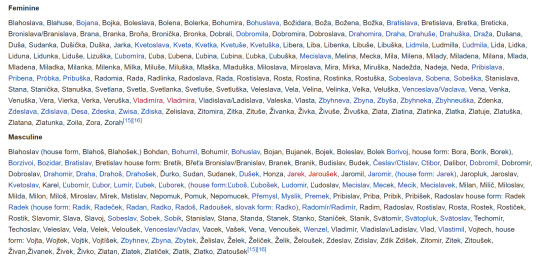
Here’s the full article on Slavic names.
While some of these names are used today, some of them aren’t at all or are used in a different, more evolved form.
Now, to the names of our characters. The most explainable and justified name here is Kate’s name. In Twilight Wiki we can find that her actual name was Katrina and that her preferable name now is Kate. Let’s see the origins of the name Kate.
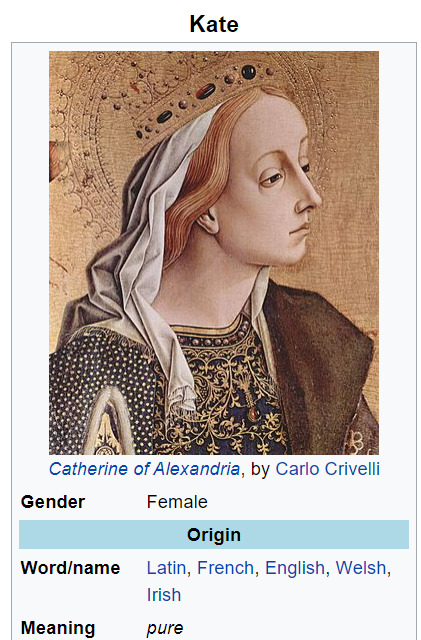
Full article here.
While we can read that variations of that name in Czech are: “ Katka, Kateřina, Kačka, Káťa, Kačenka, Káča, Kačí, Kačena” and in Slovakian “Katka, Katarína” still the origins aren’t Slavic.
Next, Irina.
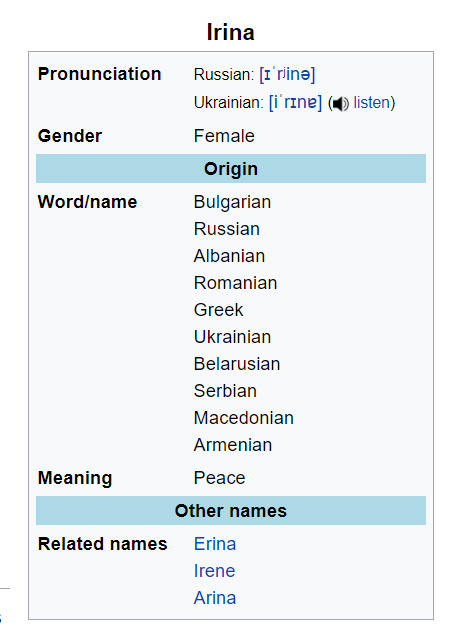
As Wikipedia says:
Irina is a feminine given name of Ancient Greek origin, commonly borne by followers of the Eastern Orthodox Church. It is derived from Eirene (Ancient Greek: Εἰρήνη), an ancient Greek goddess, personification of peace.
Diminutive forms in Slavic languages include Ira, Irinka, Irinushka, Irisha, Irka, Irochka, Irinochka.
Here, we also don’t have Slavic origin. While it’s better than with Kate’s name because origins here seem to hugely blend, the proper origin of Irina’s name is Ancient Greek. I will never believe that a peasant girl from around 1000 AD was named Irina.
Here’s the full article.
Next, Vasilli.
Wikipedia doesn’t say much, except it’s a RUSSIAN NAME with Greek origin.

Full article here.
Now, finally, we’ve two names left. First, Sasha.
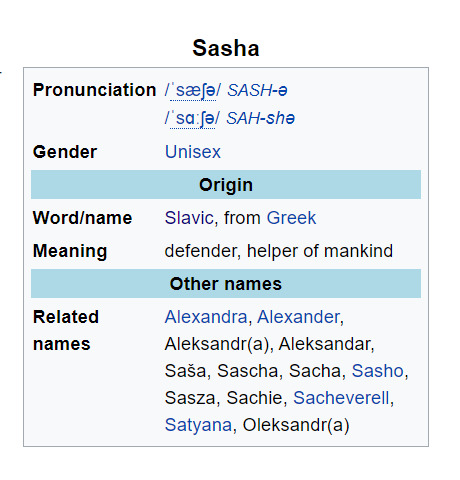
Finally, first one, which has Slavic origin. And while this name has many variations in many languages, I don’t believe that anyone in Slovakia prior to 1000 AD would name their child Sasha. This name gained popularity in 1970s, and I believe that it would be used rather as diminutive of a name in 1000 AD than a name itself.
Full article here.
Last, but not least, Tanya.
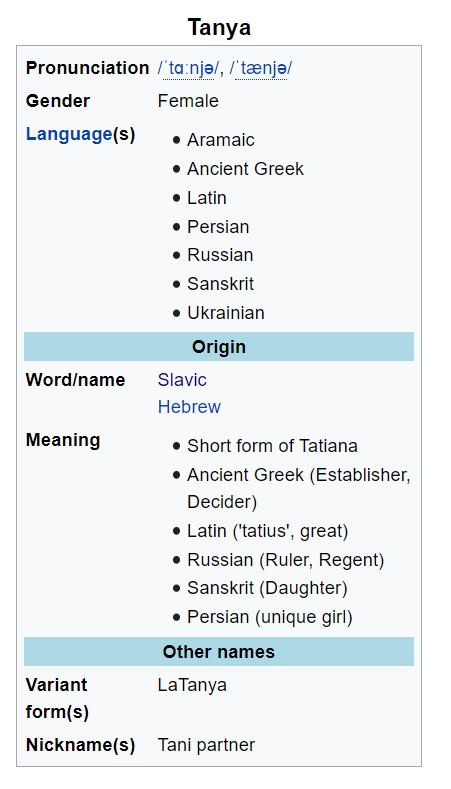
Here, also, it isn’t a full name. Full name is Tatiana, and Tanya, especially in Slavic it is used as a nickname implying intimacy with the person OR used for baby talk.
Full article here.
What’s my point here? Even though two of these five names are partially Slavic in origin, they sound like Russian names. Not Eastern Slavic in one fucking bit. Sure, Smeyer could do a simplification and say that, yeah, girls acquired other names as centuries passed. Agreed, even strongly.
BUT
Smeyer never said anything like this. Also, I’m under the impression that this names were meant to sound Russian. And, people, don’t get me wrong, I really hold nothing against Russians, but because of doing such thing Smeyer has perpetuated certain patterns and beliefs that have become firmly established in US culture and West culture in general by now.
No wonder why some people never distinguish between Russia, Slovakia, Poland, Czech Republic or Ukraine, or other countries from Easter Bloc. How can they, where in majority of mass media they’re taught that IT IS EXACTLY THE SAME THING. Why should they bother?
I have many friends among Slovakian people. Slovakia is like a second home to me. I also have a few friends from Czech Republic. And before, I’ve never been bothered by this name thing because I was a child. Today I couldn’t be silent about it.
It’s sad that another culture and fantastic history was just blended in with Russia because why not. I don’t understand why in Western movies or books all people from former Eastern Bloc need to be Russian.
I am Polish and to me it’s just extremely sad. We (and I think I can count in here Slovakia, Czech Republic, Hungary, but also Croatia or Serbia) have fantastic culture and very long, eventful history. People from these countries are welcoming and share great hospitality.
I don’t know why Smeyer did something like this, but I suppose it’s just a thing she does to everyone. Rip away their culture and pretend she didn’t do it.
I am grateful that this fandom is a lot wiser than the creator of the books. This is what I said in the beginning of this post. Smeyer could’ve gone to library and read a little about the history and the names. I mean, If she didn’t found it on the Internet, because it was 2006, I believe, so she could research it. If there was nothing on the Internet, I’m sure a library would do.
She did a poor research or didn’t do it at all. And that’s what happened. Was it worth it? I don’t think so.
***
Everyone, please, comment, but be kind to each other (and to me xd). I wrote what I felt. As I’ve told you already, I’m Polish and I really felt that I should write this meta/disclaimer from a point of view of a person who lives in Slavic-origined country and has many Slavic-origined friends.
I still feel triggered because of this. Reblog this so others could see and say what they think.
#twilight meta#slavic culture#polish culture#history#cultural and historical references in twilight#smeyer being an ignorant discourse#smeyer nonsense#this woman is bound to white supermacy#Slavic names#Polish & Slovakian historical background#twilight revival#the twilight saga#smeyer cannot use library properly#neither can she use internet#slovakian culture#why the fuck should you confuse Slovakian people with Russian people?#Hungary mentioned#twilight#twilight saga
120 notes
·
View notes
Photo

Mary of Hungary (c. 1257 – 25 March 1323), of the Árpád dynasty, was Queen of Naples by marriage to King Charles II. She was a daughter of Stephen V of Hungary and his wife Elizabeth the Cuman. Mary served as Regent in Provence in 1290–1294 and in Naples in 1295–96, 1296–98, and 1302, during the absences of her husband.
3 notes
·
View notes